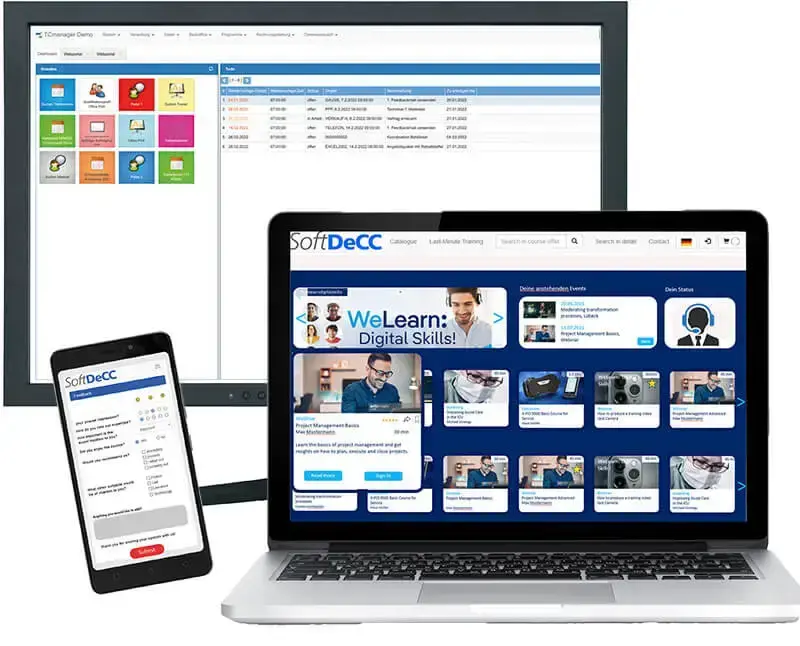The Key to Seamless Learning Management
The Challenge and Importance of Thoughtful System Integration
Implementing a modern Learning Management System (LMS) into an existing IT landscape is far more than just a technical task—it is a strategic necessity. While your new LMS offers numerous benefits, such as improved learning opportunities and efficient management, integrating it with older "legacy systems" can present a significant challenge. These legacy systems are often not designed to work seamlessly with new technologies.
A well-planned integration is therefore crucial to maximizing the strengths of your new LMS while ensuring the continuity and reliability of your existing systems.
Assessment of Existing Systems
Before starting the integration, it is essential to thoroughly examine your existing systems and assess their interoperability. Interoperability refers to the ability of different systems to work together effectively and exchange information.
- A thorough assessment helps identify and resolve potential integration issues early on, maximizing the efficiency of the system integration and minimizing system failures.
- This requires a detailed analysis of technical requirements and interfaces. Ensure that all systems use the same data standards and protocols.
Typical Legacy Systems:
HR Systems (Human Resources):
These systems manage employee data such as salaries, performance reviews, and training histories. Examples include SAP HR and Oracle PeopleSoft.
- Benefit: Connecting your LMS to the HR system allows for automatic updates of employee data, simplifying training management and ensuring data accuracy.
CRM Systems (Customer Relationship Management):
These systems support the management of customer relationships, sales processes, and marketing activities. Examples include Salesforce or Microsoft Dynamics CRM.
- Benefit: Integrating with CRM systems enables personalized training offerings based on customer interactions and needs, increasing the relevance and effectiveness of training initiatives.
ERP Systems (Enterprise Resource Planning):
These systems integrate business processes such as finance, logistics, and production. Examples include SAP ERP or Oracle ERP Cloud.
- Benefit: Connecting the LMS to ERP systems allows training and certification data to be seamlessly integrated into business processes, leading to better resource allocation and cost control.
Identifying a Well-Integrable LMS: Key Features
A well-integrable Learning Management System (LMS) has several key characteristics that facilitate seamless connection with existing IT systems. These features ensure that the LMS is not only functional immediately but also adaptable to an evolving IT landscape over the long term.

- Firstly, the LMS should offer comprehensive and well-documented APIs (Application Programming Interfaces) that enable easy integration with other systems such as HR, CRM, or ERP systems.
- Availability of standardized data formats and protocols is also crucial for ensuring smooth and error-free data transfer.
- Another important feature is middleware support, which acts as a bridge between the LMS and older legacy systems.
- Flexibility in modularity and adaptability of the system architecture ensures that the LMS can be integrated even with future expansions or changes in systems.
- Finally, the LMS should provide integration testing and support for customizations to meet specific integration requirements effectively.
APIs & Middleware: Key Technologies for Seamless Integration
Selecting and implementing the right technologies is critical for successfully integrating your Learning Management System (LMS) into your existing IT landscape. Two central components in this process are APIs and middleware. These technologies help connect different systems and enable smooth data exchange.

APIs (Application Programming Interfaces) and middleware are crucial technologies that facilitate the successful integration of your LMS into an existing IT infrastructure. APIs provide a direct and automated connection between systems, ensuring real-time data flow, while middleware acts as a flexible bridge that adapts data formats and integrates multiple systems.
Both technologies simplify the integration process, ensure data consistency, and optimize system performance.
API Strategies: Efficient System Connections through Interfaces
What are APIs?
APIs (Application Programming Interfaces) are interfaces that allow different software applications to communicate and exchange data with each other. APIs act as intermediaries, transferring specific functions or data from one system to another.
Benefits of APIs:
-
Direct Connection and Automation: APIs enable a direct connection between your LMS and existing systems such as HR or CRM systems. This automates the data flow and significantly reduces manual effort. For example, an API can be used to automatically transfer employee data from an HR system to the LMS, minimizing administrative workload.
-
Error Reduction: Automating data exchange through APIs greatly reduces errors that can occur with manual input. This increases the accuracy and consistency of data.
-
Real-Time Data: APIs often allow access to real-time data, leading to more up-to-date information and faster responses to changes. For example, if your CRM system provides real-time updates on customer interactions, these can be immediately integrated into the LMS to offer tailored training content.
Guidelines for API Usage:
-
API Documentation: Comprehensive and well-documented APIs are essential. This documentation should include detailed information about available endpoints, required parameters, and authentication requirements.
-
Security Protocols: APIs should support robust security protocols, such as OAuth for authentication and TLS for data encryption, to ensure that data is transmitted securely.
-
Versioning: APIs should be versioned to ensure that integrations continue to work even when the API is updated. Ensure you choose an API version that is stable and well-supported.
-
Example: If you use Salesforce as your CRM system, the Salesforce REST API can be used to integrate customer information, sales data, and interactions in real-time into your LMS. This allows for personalized training offerings based on the latest customer interactions.
Middleware Solutions: The Flexible Bridge Between Systems
What is Middleware? Middleware is software that acts as an intermediary between different applications, enabling communication between them. It can adapt various data formats and protocols to ensure interoperability between systems.
Benefits of Middleware:
-
Data Conversion: Middleware can convert data formats used by different systems, allowing seamless data exchange even if the systems use different data structures.
-
Integration of Multiple Systems: Middleware enables the integration of multiple systems that may not be able to communicate directly. This is particularly useful when integrating an LMS into a complex IT landscape with several legacy systems.
-
Error Handling and Logging: Middleware often provides features for error handling and logging, helping to diagnose and resolve issues in data transmission.
Guidelines for Middleware Usage:
-
Compatibility: Ensure that the middleware solution supports the systems and data formats you are using. The middleware should be able to handle all necessary protocols and formats.
-
Scalability: Choose a middleware solution that is scalable and can keep pace with your company's growth and system demands.
-
Performance: Make sure the middleware solution does not negatively impact system performance. It should operate efficiently and process data traffic quickly and reliably.
-
Example: An integration tool like MuleSoft Anypoint Platform could be used to synchronize data between an ERP system such as SAP and a new LMS. The middleware would ensure that the different data formats and structures of both systems are harmonized, and that data transmission is efficient.
Conclusion: A Seamlessly Integrated LMS offers Strategic Value
Integrating a Learning Management System (LMS) into an existing IT landscape is not merely a technical task—it's a crucial step towards creating a flexible, efficient, and future-proof organization. A well-integrated LMS allows for seamless incorporation of training and development processes into daily operations, automatic synchronization of employee data, and the application of valuable insights from customer and operational data into targeted training initiatives.

The value of successful LMS integration is evident in several key areas:
- Increased Efficiency: By automating data flows and reducing manual interventions, processes are accelerated, and errors are minimized. This leads to significant relief for IT and HR departments.
- Data Consistency and Security: APIs and middleware solutions ensure that data is consistently and securely transferred between systems. This maintains high data quality, which is essential for informed decision-making and targeted actions.
- Flexibility and Future-Proofing: A modular and adaptable integration approach ensures that your LMS can keep pace with evolving demands and technological changes. This allows new systems and technologies to be integrated seamlessly without the need for costly and time-consuming redevelopment.
- Competitive Advantage: A seamlessly integrated LMS helps to continuously and purposefully upskill your workforce. This not only strengthens your employees' capabilities but also enhances your company's ability to innovate and adapt in a dynamic market environment.
Overall, integrating an LMS offers significant benefits that extend well beyond the realm of training. With careful planning and the right choice of technologies, your organization can not only meet current demands but also reap the long-term rewards of a robust and flexible IT ecosystem.

About SoftDeCC
Since 1998 SoftDeCC is working closely with major training centers and academies. This results in a unique experience with training requirements.
Our Learning Management System is designed to adjust to individual corporate learning processes and address evolving challenges. More...

Contact us for free Consultancy
We will be happy to share our experience with you.
Call us for your free consultancy appointment: +49 (0)89 - 3090 839 30
.webp)




